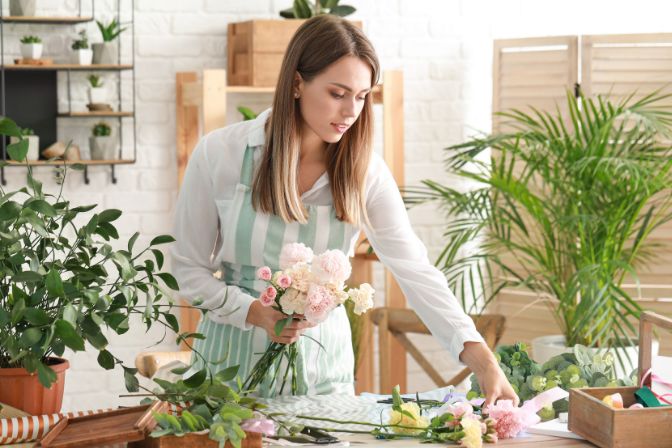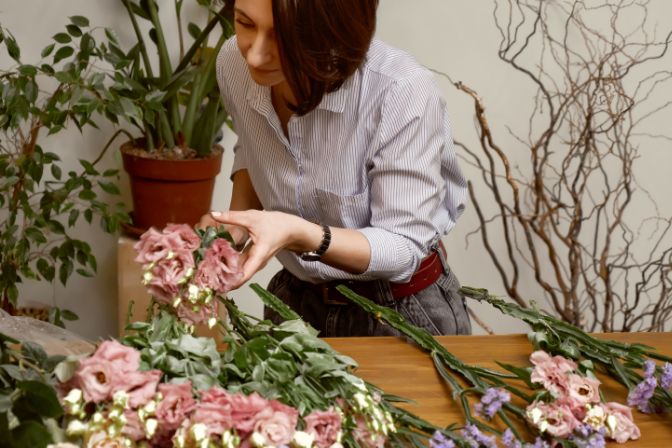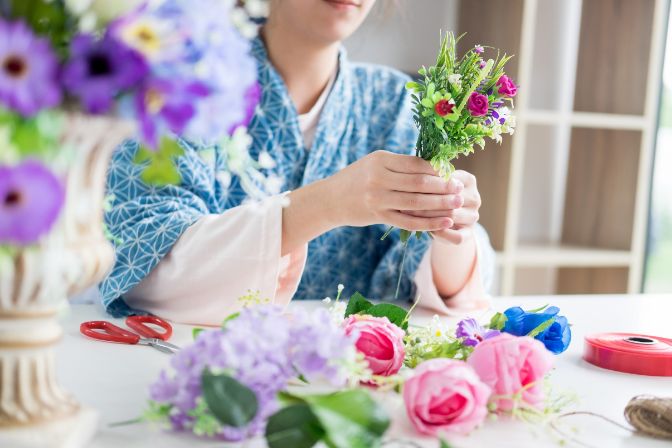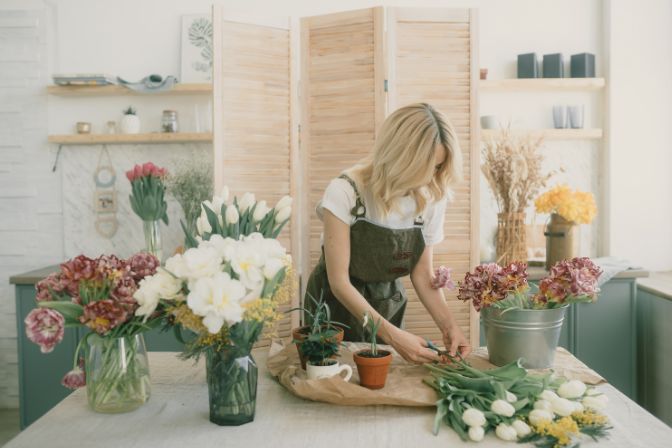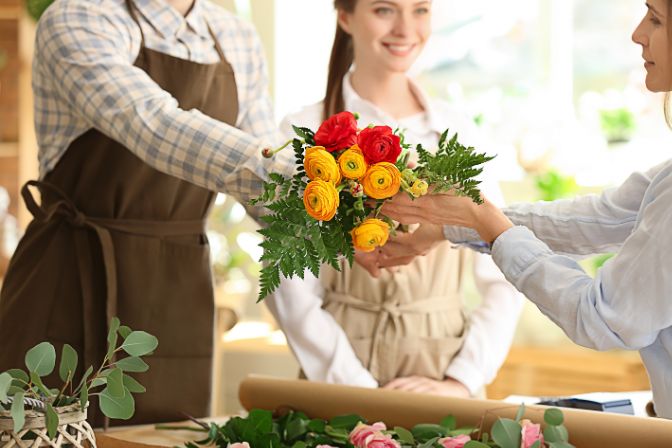
Floral Design, General Tips, Your Event Career
The 10 Must-Have Skills Every Florist Needs
If you’re thinking of becoming a florist, you’ll need to make sure you have the right skills first. This article will break down the 10 must-have skills every florist needs to be successful and run their own floral design business. These skills aren’t just about flower arranging – they also cover business knowledge, customer service and more.
So, if you’re keen on starting a career in floristry, read on for essential information about what you need to know!
PRO TIP: If you think being a florist is your dream job, then you NEED to check out our Ultimate Guide on Becoming a Florist – even if you have no experience!
Frequently Asked Questions
Before we reveal the 10 skills you need to have as a professional florist, let’s answer some frequently asked questions about this career path first…
What Is a Florist?
A florist is a professional who designs, creates and sells flower arrangements. They usually work in flower shops or floral studios, but some may also be freelance or work from home.
What Is The Floristry Job Description?
The main duties of a florist include:
- Meeting with clients
- Creating floral designs
- Arranging flowers and plants
- Purchasing flowers and supplies
- Delivering orders
- Providing customer service
Some florists may also be responsible for managing staff and/or running their own business.
What’s The Average Floral Designer Salary?
It’s important to note that there’s no one-size-fits-all answer to this question. This is because salaries can vary depending on factors such as experience, your professional qualifications, location and whether you’re employed or self-employed.
That said, we can give you a general ideas of the salary ranges florists have been making recently in the following example countries:
- United States: Between approx. $43,000 USD and $64,000 USD per year (Source: Salary.com)
- Canada: Between approx. $28,000 CAD and $42,000 CAD per year (Source: Payscale)
- United Kingdom: Between approx. £21,500 GBP and £41,600 GBP per year (Source: Talent.com)
- New Zealand: Between approx. $41,500 NZD and $68,000 NZD per year (Source: SalaryExpert)
- Australia: Between approx. $40,000 AUD and $61,000 AUD per year (Source: Payscale)
As you can see, there’s a wide range of salaries that florists can earn. This is because there are many different types of roles within the industry, from entry-level positions to experienced designers and even management roles.
Ways To Increase Your Salary As A Florist
There are also a few things you can do to try and increase your salary as a florist. Here are a few examples:
1. Get Qualified
Many employers and/or clients prefer to hire floral designers who have completed some sort of reputable certification training. So, this is definitely something that will help you earn a higher salary.
2. Gain Experience
The more experience you have, the more likely you are to be offered a higher salary (or be able to charge higher rates). Thus, if you’re just starting out, consider taking on some internships or entry-level roles to gain some valuable experience first. And if you run your own business, take the time at the beginning of your career to actively seek out new clients and projects.
3. Relocate
In general, salaries tend to be higher in developed countries such as the United States, United Kingdom, Canada, Australia, and New Zealand. So, if you’re willing to relocate, this could be a good way to earn a higher salary.
4. Offer Virtual Florist Services
If you don’t want to relocate (or have the means to), that’s alright – you have other options!
The global pandemic has forced many businesses to pivot and offer their services online. And as more and more people are shopping for flowers online, this is something you could consider doing as well. Not only will it help you reach a wider audience, but it can also be a great way to earn a higher income.
5. Offer Additional, Relevant Services
Another way to increase your earnings as a florist is to offer additional services that are related to your craft. For example, you could offer:
- Flower arranging classes
- Wedding or event planning
- Home decor services
- Event decor services
By expanding the services you offer, you’ll be able to reach a wider range of clients and charge higher rates for all of your services as a whole.
6. Start Your Own Business
If you’re self-employed, the sky’s the limit in terms of earnings potential! Of course, this does mean you’ll have to work harder and put in more hours. But it could be worth it if you’re motivated by money, want to be your own boss, and desire creative freedom.
Pros and Cons of Being a Florist
Like any career, there are both pros and cons of being a florist. Here’s a quick overview of some of the most common ones:
Pros:
- Can be creative and expressive
- Can be therapeutic and calming
- Good physical activity (can help reduce stress)
- Potentially high earnings potential (especially if self-employed)
Cons:
- Can be physically demanding (e.g., lifting heavy buckets of water)
- Requires regular access to fresh flowers (which can be expensive)
- May require working long hours or irregular shifts (especially during busy periods such as Valentines Day, Mothers Day, etc.)
PRO TIP: To get a thorough idea of what a typical day in the life of a florist looks like, check out this blog article!
What Are The 7 Principles of Floral Design?
The seven principles of floral design are:
- Balance
- Contrast
- Dominance/Subordination
- Proportion/Scale
- Rhythm/Movement
- Unity/Harmony
- Variety/Interestingness
Let’s break down each one individually, shall we?
1 – Balance
In design, balance refers to the distribution of visual weight within a given space. There are two types of balance you can use in your floral designs: symmetrical and asymmetrical.
Symmetrical balance is when the elements on one side of the design mirror those on the other side. This creates a sense of stability and orderliness in the design. On the other hand, asymmetrical balance is when the elements on either side of the design are different, but still work together to create a sense of harmony. This type of balance is often seen as more dynamic and interesting than symmetrical balance.
Pro tip: When using asymmetrical balance in your designs, make sure to use odd numbers of elements (e.g., three flowers instead of four). This will help create a more pleasing and visually interesting design.
2 – Contrast
Contrast is the use of opposite elements to create visual interest. The most common type of contrast used in floral design is color contrast. This is when you pair together two colors that are on opposite ends of the color wheel (e.g., yellow and purple, red and green, blue and orange).
Other types of contrast you can use in your designs include:
- Light vs. dark
- Rough vs. smooth
- Warm vs. cool
- Soft vs. hard
By using contrasting elements in your designs, you can create more visually interesting and eye-catching arrangements!
Pro tip: When using color contrast in your designs, make sure to use complementary colors (e.g., blue and orange, red and green). This will create a more harmonious and pleasing design.
3 – Dominance/Subordination
Dominance and subordination refer to the hierarchy of elements in a design. In other words, it’s the order in which your eye is drawn to the different elements in the design. There are two ways you can create dominance and subordination in your designs:
- Size – This is when you use larger elements to draw attention to a certain area of the design, while smaller elements take a subordinate role.
- Color – This is when you use lighter colors to draw attention to a certain area of the design, while darker colors recede into the background.
Pro tip: When using size or color to create dominance and subordination, make sure that the dominant element is also the most important element in the design (e.g., the focal flower). This will help ensure that the design is balanced and visually appealing.
4 – Proportion/Scale
Proportion and scale refer to the size of the elements in relation to each other and the overall design. The most important thing to keep in mind when working with proportion and scale is that the elements should be in proportion with each other (e.g., all the flowers are the same size).
Another thing to keep in mind is that the overall scale of the design should be appropriate for the space it’s going into. For example, a large arrangement would look out of place in a small room, while a small arrangement would get lost in a large room.
Pro tip: When working with proportion and scale, make sure to use odd numbers of elements (e.g., three flowers instead of four). This will help create a more pleasing and visually interesting design.
5 – Rhythm/Movement
Rhythm and movement refer to the way the eye moves through the design. You can create rhythm and movement in your designs by repeating certain elements (e.g., using multiple flowers of the same color or type) or by using a variety of different elements (e.g., using different colors, textures, and sizes of flowers).
Pro tip: When creating rhythm and movement in your designs, make sure to use a variety of different elements. This will help keep the design interesting and visually appealing.
6 – Unity/Harmony
Unity and harmony refer to the way all the elements in the design work together to create a sense of cohesion. In other words, unity and harmony are about creating a design that is pleasing to the eye and easy to understand.
You can create unity and harmony in your designs by using similar colors, shapes, and/or textures throughout the design. You can also use repetition and rhythm to create unity and harmony.
Pro tip: When creating unity and harmony in your designs, make sure that all the elements work together harmoniously. This will help ensure that the design is balanced and visually appealing.
7 – Variety/Interestingness
Variety and interestingness refer to the way the design is visually interesting and pleasing to the eye. You can create variety and interestingness in your designs by using a variety of different elements (e.g., different colors, sizes, and textures). You can also use contrast, rhythm, and movement to create interest in your designs.
Pro tip: When creating variety and interestingness in your designs, make sure to use a variety of different elements. This will help keep the design visually stimulating and enjoyable to look at.
By keeping these seven design principles in mind, you’ll be well on your way to creating beautiful and eye-catching floral designs!
What Is Color Harmony in Floristry?
Color harmony is when you use colors that work well together in a design. You can create color harmony in your designs by using a color wheel.
The color wheel is a tool that helps you to understand which colors work well together. The color wheel is made up of three primary colors (red, yellow, and blue), three secondary colors (orange, green, and purple), and six tertiary colors (red-orange, yellow-orange, yellow-green, blue-green, blue-purple, and red-purple).
Pro tip: When creating color harmony in your designs, make sure to use a variety of different colors. This will help keep the design visually interesting and pleasing to the eye.
What Are Four Major Lines Used in Floral Design?
The four major lines used in floral design are curved, zigzag, diagonal, and horizontal.
- Curved lines are created when two points are connected by a curve. Curved lines can be either soft or hard.
- Zigzag lines are created when two points are connected by a series of alternating curves. Zigzag lines can be either soft or hard.
- Diagonal lines are created when two points are not on the same plane. Diagonal lines can be either soft or hard.
- Horizontal lines are created when two points are on the same plane. Horizontal lines can be either soft or hard.
Pro tip: When using line in your designs, make sure to use a variety of different types of lines. This will help keep the design visually interesting and pleasing to the eye.
What Is Form in Floral Design?
Form is the three-dimensional shape of an object. You can create form in your designs by using a variety of different materials (e.g., wire, ribbon, and fabric). When creating form in your designs, make sure to use a variety of different materials. This will help keep the design interesting and aesthetically pleasing.
What Is Texture in Floral Design?
Texture is the way an object feels. You can create texture in your designs by using a variety of different materials (e.g., paper, fabric, and ribbon). When creating texture in your designs, make sure to use a variety of different materials. This will help keep the design visually interesting and pleasing to the eye!
What Is Third Dimension in Floristry?
Third dimension is the level of depth in a design. You can create third dimension in your designs by using a variety of different materials (e.g., wire, ribbon, and fabric). Creating third dimension is useful because it can add interest and visual appeal to a design.
What Is Negative Space in Floristry?
Negative space is the empty space around and between the elements in a design. You can create negative space in your floral designs by using a variety of different materials (e.g., wire, ribbon, and fabric). Alternately, you can also create negative space by not using any materials at all!
Visually, the main benefit of negative space is that it can help to make a design appear more open and airy.
Skills For Florists: Do You Need a Professional Certification?
No, you do not technically “need” a professional certification to work as a florist. That said, however, it’ll be hard to set yourself up for success without one! After all, employers and clients won’t be inclined to hire you if you can’t prove that you know what you’re doing – and have taken the time to earn your stripes!
For this reason, many florists choose to pursue professional certification in order to improve their skills and increase their knowledge about the industry. There are a variety of different professional certifications available for florists, such as the Floral Design Course offered by QC Event School.
About QC Event School
QC Event School is a faculty of QC Career School, a pioneer of distance learning since 1984. All of QC’s courses are entirely self-paced and done online. This means that you have the flexibility and freedom to earn your globally-recognized International Floral Design Professional (IFDP) certification + designation whenever (and from wherever) you want!
Moreover, QC Event School holds an A+ ranking with the Better Business Bureau, as well as approval from the International Live Events Association (ILEA). Countless graduates of QC Event School have since gone on to launch lucrative careers in the following fields:
- Event planning
- Wedding planning
- Corporate event planning
- Event decorating
- Floral designing
- Luxury event/wedding planning
- Destination event/wedding planning
- Promotional planning
- Live event/festival planning
- Travel and tourism
- Virtual event/wedding planning
If you’re interested in learning more about QC Event School, or connecting with us directly, we welcome you to check us out on the following social media platforms:
If you have any questions or wish to speak with a member of QC’s awesome Support Staff, you can also reach out via email, phone, or live chat (depending on your personal preference)!
QC Event School’s Floral Design Course
In this 7-unit online program, you’ll learn everything needed to launch your career as a professionally-certified floral designer/florist. Here’s a sneak peek of what will be covered in each unit…
Unit A
- Different career paths you can pursue as a floral designer
- The history of floral design
- The most popular and common kinds of floral arrangements and designs
Unit B
- Plant anatomy and care
- Tools and supplies needed to care for your florals and build designs
- How to process and prepare flowers with step-by-step instructions
- How to process and prepare flowers for design with step-by-step instructions
- The mechanics involved in structuring a variety of different floral designs
- The principles and elements of design
- Creating a floral design plan that covers every step/element of your design
Unit C
- The essential design considerations when creating decorative arrangements
- Flower selection and proper placements
- Different methods of accessorizing
Unit D
- Designing flowers to wear and carry
- How to create customized designs for each client and their special event
- How to structure and design bouquets, corsages, and boutonnieres
- Ways to keep plants fresh when out of water
Unit E
- Applying fundamental floral design techniques to create advanced designs
- Creating specialty floral designs (e.g., garlands, aisle decor, large arrangements, and wreaths)
- Using faux flowers and other alternatives
Unit F
- Various types of businesses and the best option(s) for your career as a florist
- The steps involved in starting your very own business
- Marketing your business so you can stand out from the competition
- Options at your disposal for buying wholesale flowers
- Managing your floral inventory
- Effective communication and sales strategies to interact with clients and increase your number of sales/bookings
Unit G
- Special instruction/advice by events industry sensation, Mwai Yeboah
- How to position your brand
- Adding floral design to existing event/wedding packages
- Creating and executing a floral design plan
- Tips for effectively communicating with clients
- And more!
The best part? Since YOU get to decide how often you work on your studies, you can graduate and earn your floral designer certification in as little as 3-6 months (maybe even sooner)!
View the full details for QC’s Floral Design Course here and get started today!
The 10 Must-Have Skills Every Florist Needs
In order to be a successful florist, you need to have certain skills and knowledge under your belt. Here are the 10 must-have skills every florist needs:
Skill #1: Excellent Customer Service Skills
As a florist, you will be working with customers on a regular basis. As such, it’s critical that you have excellent customer service skills so that you can build positive relationships with your clients.
What do we mean by this?
You should be able to effectively communicate with your clients, understand their needs, and provide them with the best possible service. This includes being patient, friendly, and helpful at all times.
And yes, this even includes providing high-quality customer service when someone is being rude to you, or leaves a negative review online. While it may sometimes feel difficult, remember that how you respond to a bad situation can make or break your business. So, always approach client situations from an objective perspective, rather than a personal (emotional) one.
So long as you remain friendly, respectful, and professional, you’ll maintain a positive reputation for your business… And keep the customers coming in!
PRO TIP: Need help sharpening up your customer service skills? This article by Qualtrics offers 19 tips to help you get to where you want be!
Skill #2: A Passion For Floristry
Of course, this one is a given. To be a successful florist, you need to have a passion for the art of floral design. This means not only being creative and having an eye for detail, but also staying up-to-date on the latest trends in the industry.
Passionate florists are always looking for ways to improve their skills and grow their business. They’re constantly learning new techniques and experimenting with different styles. And most importantly, they absolutely love what they do!
If you don’t have a passion for floristry, it’s going to be very difficult to succeed in this career. So before you take the plunge, make sure that this is something you really see yourself doing long-term.
Skill #3: Business Training
The floral industry is a business, which means that you need to have some basic business skills if you want to be successful. This includes things like knowledge about bookkeeping, marketing, and product pricing.
While you may not need an extensive background in business to be a florist, it’s still important to have at least a basic understanding of these concepts. After all, you are running your own business! And the better equipped you are with business skills, the more likely you are to succeed.
Fortunately, there are plenty of resources out there to help you brush up on your business skills. The Small Business Association is a great place to start. They offer tons of free resources and advice for small businesses, including florists.
And, as you may have noticed earlier, there’s an entire unit in QC Event School’s Floral Design Course devoted to business training, too!
Skill #4: An Understanding of Proper Floral Design Techniques
We feel like this one also goes without saying. To be a successful florist, you need to have an understanding of proper floral design techniques. This includes everything from choosing the right flowers for your arrangement, to using the correct tools and supplies.
If you’re not familiar with the basics of floral design, don’t worry! There are plenty of resources out there to help you learn. For example, as we went over earlier, QC’s Floral Design Course covers all of the essential techniques you’ll need to know as a florist.
Skill #5: An Eye For Design and Creativity
Creating beautiful floral arrangements is obviously a huge part of being a successful florist. But it’s not just about choosing pretty flowers and putting them in a vase. To be a truly great florist, you need to have an eye for design and a creative mind.
What do we mean by this? Having an eye for design means being able to create arrangements that are both aesthetically pleasing and structurally sound. It’s about knowing how to use negative space, balance colors, and create interesting texture contrasts.
In short, it’s about having a creative vision… And the ability to execute that vision flawlessly.
If you’re not naturally gifted in the design department, don’t worry! There are plenty of ways to improve your skills. One great way is to simply study the work of other florists that you admire. Pay attention to the elements that make their arrangements so beautiful, and try to incorporate those same elements into your own work.
You can also find tons of helpful resources online, like this list of design tips for beginner florists from Team Flower.
Skill #6: A Head For Numbers
Running a successful floral business is not just about being creative. It’s also about being able to manage your finances and stay organized. This is where having a head for numbers comes in handy!
As a florist, you’ll need to be comfortable with things like bookkeeping, budgeting, and prices your products and services. Furthermore, you’ll need to be able to track your expenses, set financial goals, and make smart decisions about how to grow your business.
If math has never been your strong suit, there’s no need to panic! You can find plenty of resources out there to help you get better with numbers and finances. And again, QC’s Floral Design Course offers an entire unit devoted specifically to business training… So, you can brush up on your financial skills before you even start your business!
Skill #7: Physical (and Mental) Stamina
Working as a florist can be pretty demanding, both physically and mentally. To be successful in this career, you need to have the stamina to handle long hours on your feet, as well as the mental fortitude to deal with challenging situations (like difficult customers).
Of course, there are ways to make things easier on yourself. Wearing comfortable shoes and taking breaks when you need them can help reduce physical fatigue. Plus, learning how to manage your time effectively can help you stay sane when things get busy.
But at the end of the day, being a florist requires a certain amount of physical and mental stamina. If you don’t think you have what it takes, maybe this isn’t the right career for you… However, if you are up for the challenge, then this career path is definitely worth going for!
Skill #8: The Ability to Work Under Pressure
Next, on our list of 10 must-have skills for florists, is the ability to work under pressure. As we mentioned before, being a florist can be pretty demanding. There will be times when you’re dealing with long hours, difficult customers, and challenging design requests.
In these situations, it’s important to be able to stay calm and focused. This way, you can avoid making mistakes and deliver the best possible product or service to your customer.
Of course, there’s no magic formula for staying calm under pressure. However, there are some things that you can do to help yourself out. For example, learning how to manage your time effectively can go a long way in reducing stress levels. Plus, taking breaks when you need them can also help you stay fresh and focused.
Skill #9: The Ability to Sell
Another must-have skill every florist needs is the ability to sell. Even if you’re the most talented florist in the world, you won’t be successful unless you can sell your products and services.
Being a good salesperson is all about understanding your customer’s needs. This way, you can find the right way to pitch your products and/or services. And, of course, it’s also important to be able to build rapport with your customers and make them feel comfortable doing business with you.
Now, if selling isn’t your strong suit, don’t worry! This doesn’t come naturally to everyone. Luckily, there are plenty of resources out there to help you improve your sales skills – such as this article by HubSpot.
(And again, QC’s Floral Design Course offers an entire unit devoted specifically to business training. With our training, you’ll be able to hone your sales skills before you even start your business!)
Skill #10: Patience and Self-Motivation
We know, we know… Technically, these are two separate skills. But they’re both so important, we couldn’t leave one out of this list!
Firstly, being a florist requires a lot of patience. After all, there will be times when (as we’ve mentioned before) you’re dealing with challenging customers, difficult design requests, and long hours on your feet. In these situations, it’s important to be able to stay calm and focused.
Similarly, self-motivation is equally as key in this career path. As a florist, you’ll be your own boss. This means it will be up to YOU and you alone to stay motivated and focused on your goals.
Of course, there are ways to make things easier on yourself. For example, setting realistic goals and breaking them down into small steps can help you stay motivated. Plus, surrounding yourself with positive people can also give you the boost you need to keep going!
The Skills You Need To Work As a Florist: What To List On Your Resume
While the above skills are the core things you’ll need for your long-term career to thrive, should you be listing these on your actual resume?
The answer, unfortunately, is not all of them.
While it’s great to have a wide range of skills, your resume should be focused on the specific skills and experience that make you qualified for the job you’re applying for. For example, if you’re applying for a position as a wedding florist, then you would want to focus on your experience with weddings (as opposed to your experience with funerals).
Keywords To Consider
That said, there are some universal keywords related to floristry that might do well to be listed on your resume. For example, some of the most popular keywords our course students use are “flower arranging,” “event planning,” and “customer service.”
Similarly, if your resume has a “Skills and Qualifications” section (which we recommend having), you could consider listing skills/qualities like:
- Artistic ability
- Good organizational skills
- Excellent customer service skills
- Detail oriented
- Able to work well under pressure, etc.
If you’re not sure what keywords to use on your resume, we recommend taking a look at this list of resume keywords by occupation. From there, you can tailor your resume to better highlight the skills and experience that make you qualified for the job you’re applying for!
In case this helps, here are some additional resources you can use to put together a solid resume:
- A Beginner’s Guide to Making a Resume
- 240+ Resume Templates For Jobs
- 43 Resume Tips That Will Help You Get Hired
- 500+ Resume Examples That Get Jobs
- Writing a Cover Letter (With Tips and Examples)
5 Bonus Tips For a Successful Career as a Florist
Tip #1: Put Together a Professional Portfolio
As a florist, one of the best things you can do to market your business is to put together a professional portfolio. This will give potential clients and employers alike an idea of your style, as well as what they can expect if they hire you.
In your portfolio, you should include photos of your previous work and (if applicable) as any press you’ve received. If you don’t have a lot of experience yet, that’s okay! You can always put together a portfolio with mock arrangements or even photos from magazines/websites that inspire you. Another excellent idea is to take part in a stylized photoshoot, wherein you’ll be provided high-quality images in exchange for your floral design work.
PRO TIP: You can also take QC Event School’s online Accelerate Your Business Workshop to learn everything you need to know about developing your portfolio from scratch!
Tip #2: Join a Professional Organization
Another great way to network and grow your career as a florist is to join a professional organization. For example, the Society of American Florists (SAF) is the largest trade association for floral designers in the United States. Other relevant associations include, but aren’t limited to the:
- Canadian Professional Floral Designers Association
- Flowers Canada
- Australian Floral Art Association Inc.
- Fédération Nationale des Fleuristes de France
- FDF Trade Association of German Florists
- European Federation of Professional Florists’ Associations (FEUPF)
- Floral Art Society of New Zealand (FASNZ)
- Asociación Española de Floristas Interflora
- British Florist Association
- National Alliance of Floral Associations (NAFA)
Joining an organization like this not only allows you to network with other professionals in your field; it also gives you access to exclusive industry resources, educational opportunities, and even discounts on things like business insurance.
Tip #3: Make a Website for Your Florist Business
In today’s day and age, it’s essential to have an online presence for your business – no matter what industry you’re in. And as a florist, one of the best ways to do this is to create a website for your floral design business.
Your website doesn’t have to be complicated or expensive; it just needs to be professional and informative. Include things like your contact information, pricing, photos of your work, an option for online booking, and (if applicable) any testimonials from past clients. You can also use your website as a platform to sell arrangements or bouquets online, as well as link visitors to your social media platforms!
Not sure where to start? We recommend using WordPress or Squarespace – two user-friendly (and affordable) website builders that are perfect for small businesses.
Tip #4: Get Your Business On Social Media
Building upon Tip #3, it’s more important than ever to have an online presence for your business. And in addition to your website, we’re also talking about being active on social media, too.
Nowadays, potential clients are likely to look you up on Instagram or Facebook before they even consider hiring you. That’s why it’s so important to make sure your social media accounts are up-to-date and professional.
This doesn’t mean you have to be boring – quite the contrary, actually! Rather, feel free to show off your personality and let your followers get to know you. Just make sure the overall tone of your posts is respectful, appropriate, and accurately reflects your business’s brand.
Not sure where to start? Check out this helpful blog post on how to market your floral design business on social media.
PRO TIP: Don’t forget to use relevant hashtags, too! This will help you reach a wider audience and attract new followers.
Tip #5: Pair Your Florist Services With Other Related Industry Services
We briefly touched on this earlier on, but let’s look at it a little deeper now.
One of the best ways to market and grow your florist business is to expand upon your skills and qualifications in order to offer additional services that complement floral design. For example, you could start offering:
- Event planning services
- Wedding coordination/planning services
- Event decor
- Corporate event planning services
- Virtual planning services
- Live event and festival planning services
- Promotional event planning services
- Home decor services
By expanding your services in this way, you’ll not only attract new clients; you’ll also be able to increase your overall earnings, too. And best of all? You probably already have a lot of the necessary skills!
And if you don’t?
QC Event School offers courses on all of the above fields (minus home decor)!
PRO TIP: Interested in home decor services? Then head on over to our sister school, QC Design School, to check out all of the online certification programs we offer in home design!
Conclusion
We hope this article has given you a better understanding of the skills every florist needs to be successful. If you’re interested in pursuing a career in floristry, then we highly recommend checking out QC Event School’s Floral Design Course! We also welcome you to check out our blog, Pointers for Planners, for even more awesome career advice and industry tips!
Got any questions for us? Don’t hesitate to drop them in the comments below, as we’d love to hear from you. And as always, thank you so much for reading! 🙂
